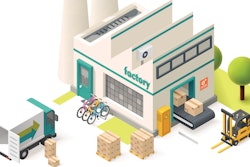Business adoption of new technologies often flows from the personal use of these technologies. This can certainly be said when it comes to mobile apps and devices; the ability to download an app in  seconds, share photos and data via the Cloud in real-time, and communicate from any location at any time have evolved from “nice to have” to “need to have.”
seconds, share photos and data via the Cloud in real-time, and communicate from any location at any time have evolved from “nice to have” to “need to have.”
These consumer-grade technology expectations are just beginning to spill over to the business world. Yet, despite increased adoption of mobile devices and technologies, paper forms are burying manufacturing businesses today. Consider that the average office worker goes through 10,000 sheets of paper each year, which means that at an estimated cost of $40 per case of paper, businesses are spending $80 annually on paper per worker.[1] The sheer volume of paper not only costs your business money, but it also grinds productivity to a halt. It takes 18 minutes on average to find a paper document, and a whopping 70 percent of businesses would fail in three weeks if they had a catastrophic loss of paper due to a fire or flood.
The costs and inefficiencies of paper forms are no longer lost on manufacturing businesses that are ramping up efforts to shift paper forms and manual processes to mobile apps — and to integrate mobility with key business processes. A 2014 survey Canvas conducted of more than 1,100 business and IT decision makers found that 63 percent of businesses see value in integrating core business applications such as Dropbox, Square, Salesforce, Evernote and Quickbooks with mobile devices and tools.
The Canvas survey points to an increasingly mobile manufacturing workforce that is looking to extend more day-to-day business processes to their mobile devices, and strongly suggests structured and unstructured data collection and collaboration apps are rising to the top of the business decision maker wish list. When it comes to specific tasks manufacturing businesses are using mobile apps for, respondents in the Canvas survey cited:
- Inspections (48 percent)
- Work Orders (36 percent)
- Surveys (23 percent)
- Invoices (21 percent)
- Checklists (18 percent)
- Inventories (6 percent)
- Other (23 percent)
Getting from paper forms to mobile apps is not without technology, business and cultural challenges. Part of the reason that businesses — particularly small to mid-sized firms lacking the budget or internal resources to undertake mobile IT projects — cling to archaic paper processes and Excel spreadsheets is a fear that developing a custom mobile app will prove costly and time intensive. With custom mobile app development often costing over $50,000 and three months of IT time and resources, this fear has merit.
Some also harbor concerns around moving hard data that exists on paper to the Cloud, maintaining control and security of customer and business data, and introducing new processes to employees who are set in their ways.
But these obstacles continue to fade; today, mobile business apps are accessible to manufacturing businesses of any size due to the benefits and economics of the Cloud and Do-It-Yourself app builder tools that eliminate traditional costs associated with custom app development, reduce the need for internal IT and development resources, and speed time to market from app creation to deployment across your workforce.
As a result, your business can now rapidly and affordably shift from paper forms and experience five key cost saving, productivity, and customer experience benefits that a cloud-based mobile app solution delivers.
Mobile time cards enhance workforce visibility
Manufacturing businesses with mobile workforces often struggle to see in real-time what workers are doing on a daily and even hourly basis, where they are at any given point in time, and if they are being as productive as they could be. Paper forms compound this problem because it can often be several hours or even days before a mobile worker returns to the office, files paperwork and enters customer and project information into your system.
Cloud-based mobile apps provide greater visibility into workforce productivity in several ways. For example, businesses with workers who rely heavily on mobile devices are fully aware that time cards are crucial for tracking employee time worked and thus, labor costs for projects. Traditional time cards present their own challenges, but by creating a time card mobile app, businesses can have the time automatically entered to ensure accuracy, and that information can be sent in real-time via the Cloud to the office. Greater accuracy means fewer issues, and allow you to spend less time tracking employees and more on their actual work performance.
 Mobile work orders improve workforce productivity
Mobile work orders improve workforce productivity
For businesses with mobile workers, tracking how many jobs each employee does in a week can be cumbersome and time consuming with paper work orders. They can also be hard to read, inconsistently returned to the office, lost or damaged, and impossible to get in real time. At a more granular level, fields often aren’t filled in fully or correctly, and pricing is entered or calculated incorrectly.
The result? Your sales cycle grinds to a halt as a result of these delays. For a business owner, paper forms make it time consuming to know which employees are productive and which ones aren’t. Mobile work orders create a system that's reliable, accurate, and accessible in real time. Companies are able to use time and date stamps to show an accurate timing of when the job occurred, while built-in GPS capabilities can confirm a worker was at a job site or customer location when he or she is supposed to be there. Manufacturing businesses also have the flexibility to customize the work order form fields to their specific requirements, pre-populate pricing for parts and have all of the information captured in the mobile work order form transmitted immediately via the Cloud to the office, as well as to customers if required.
Mobile GPS capabilities streamline vehicle routing
A cloud-based mobile app solution can also improve routing efficiency as you dispatch workers to job sites and customer locations. With GPS location capture, business owners can visualize routes on a map, consolidate two routes into one, or even calculate date and time. A light dispatch service also allows companies to send delivery information to remote or field workers, and a careful review of routes can save hundreds of gallons of gas, as well as wear and tear on vehicles.
Mobile inspections improve quality control
For businesses charged with conducting quality control, safety and compliance inspections at work sites, paper forms introduce several vulnerabilities and inefficiencies. Workers could report inspecting a site they never visited, and workers must rewrite the same information over and over, use expensive carbon copies that are hard to read and easily lost, and are limited to text-only data.
Mobile inspection apps allow your business to build in time and date stamps – as well as GPS location – to ensure inspections are being done correctly and in accordance with company and industry regulations. Mobile inspection apps also allow for multimedia (photos, etc.) to more easily report complicated issues and provide visual proof of issues.
Time and date stamps as well as GPS location assure you accurate and effective inspections.
Mobile apps transform data collection and storage
The Canvas survey left little doubt that manufacturing businesses are using or considering use of business applications for a number of processes that used to be paper-intensive or manual in nature.
- More than half (52 percent) of businesses are using file storage applications, and of those businesses using file storage applications Dropbox is the dominant choice (51 percent).
- 23 percent of businesses surveyed use note taking software or applications such as Evernote for their business.
- 33 percent use a CRM system in their business, with Salesforce commanding the most (41 percent) users.
- 47 percent of businesses surveyed use an accounting application, with Quickbooks (41 percent) the most heavily used.
Integrating mobility into core applications that your business uses every day places a premium on effective data collection that can be easily stored and shared across the organization. With mobile data collection capabilities, your employees can fill out information anywhere and have that data stored securely in the Cloud (a huge cost savings driver as each four-drawer filing cabinet costs a firm $1,500 annually. By using Application Program Interfaces (APIs), your business can easily integrate data collected via mobile apps with your own systems such as Salesforce and Quickbooks. Finally, with mobile data collection capabilities, your business can collect an expanded set of information beyond text through image capture, barcode scanning, e-signatures and GPS.
Cloud mobile business app solutions are now simple and powerful to use, and lead to significant and immediate productivity gains and cost savings for manufacturing businesses with mobile workers that are reliant on paper forms.
Jason Peck is director of marketing at Canvas, a leading provider of cloud-based software that enables businesses to find, customize and create mobile forms that replace paper forms.
[1] Visualizing Paper Waste Infographic. http://visual.ly/visualizing-paper-waste?utm_source=visually_embed























